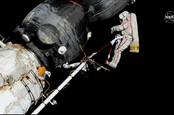This article is more than 1 year old
Clever girl: SpaceX's Mars-bound Raptor engine looks like it works just fine
Plus: Lucy in the sky with Trojans, and ISS 'nauts splash around in a water party
Roundup Over the past week in space, SpaceX pressed go on the first flight Raptor, the Lucy mission inched closer, and the ISS crew battled with some dodgy plumbing.
SpaceX fires up the first flight engine for Starship
Ol' Musky was justifiably chuffed with his band of boffins as a team of engineers fired up the first flight Raptor.
— Elon Musk (@elonmusk) February 4, 2019
It was a brief run but – and this is very important – nothing blew up. The green tinge of the flame that belched out from the power plant for Musk's Starship was either the result of camera saturation or copper from the chamber of the beast.
Musk was present for the firing. Billionaire rocketry rival Jeff Bezos, whose Blue Origin beat SpaceX to the fiery-end-down-landing-first crown, was watching the Super Bowl while development of his own beefy BE-4 engine continued.
The BE-4 is expected to produce a tad more thrust than the Raptor, with roughly 550,000lbf (about 250 ton-force or 2,400 kN) on tap. Musk intends to house his engines in SpaceX rockets, but Bezos will be selling his to the United Launch Alliance (ULA) as well as using them in his New Glenn booster.
ULA inks a deal to send NASA to Jupiter
While the BE-4 is lined up to power ULA's Atlas V successor, the workhorse itself was given the nod last week by NASA to launch its ambitious Lucy mission to Jupiter's Trojans.
.@NASA_LSP selected ULA’s reliable #AtlasV rocket to launch @NASALucy2Trojan in 2021 from SLC-41 at Cape Canaveral. We are honored to support Lucy! Atlas V also launched Curiosity, OSIRIS-REx, New Horizons, MAVEn and other iconic missions from this pad. https://t.co/JiFSqS2SRd pic.twitter.com/ly2Ph6VA52
— ULA (@ulalaunch) January 31, 2019
Planned for launch in October 2021 atop an Atlas V from Cape Canaveral's Space Launch Complex 41, the Lucy mission is destined to take a close look at the cloud of asteroids that orbit ahead and behind Jupiter (known as Trojans). The same type of rocket was used to send NASA's InSight lander to Mars in 2018.
The Discovery-class mission is designed to endure a 12-year trip checking out seven types of asteroids, a Main Belt asteroid and six of the Trojans. Some clever trajectory planning will have the probe explore a variety of destinations in independent orbits around the Sun. And the name? A reference to the fossilised human ancestor dubbed "Lucy", chosen because scientists hope analysis of the primitive bodies will give further insight into the origins of the solar system.
The name is, sadly, not a direct reference to Arthur C Clarke's 2061, where characters use the moniker as a codeword for a mountain of diamond on Europa. Like Lucy's remains, Clarke's characters were also thinking of the 1967 Beatles song.
The ISS springs a leak. Water, not air this time
While engineers gazed starry-eyed into the future, International Space Station 'nauts faced issues of a somewhat more down-to-earth nature as 11 litres of water leaked into the orbital outpost during prep work for the upcoming Urine Transport System.
According to a report by Chris Bergin of NASASpaceflight.com, the crew had unplugged the Quick Disconnect (QD) that supplies water to the Waste Hygiene Compartment (WHC) aboard the station but were soon reaching for a "significant" number of towels as water leaked from the thing.
The ISS crew is well-versed in all manner of contingencies and with the last bunch of the space station's inhabitants having had to deal with an actual leak of precious air into space, a bit of water from the plumbing presented little drama.
Had it been liquid of a different yellow-tinged nature, then things could have been considerably more icky.
The crew isolated the leak and finished up the preparations for the UTS. NASA boffins on the ground reckon that no significant amounts of water seeped behind the station's racking.
Russia has yet to suggest that the leak was the result of a 'naut fiddling with power tools. ®

